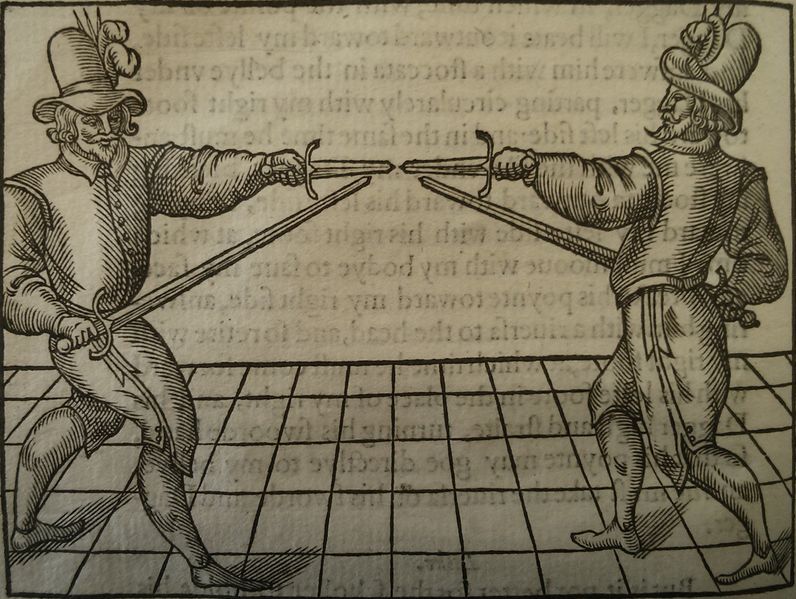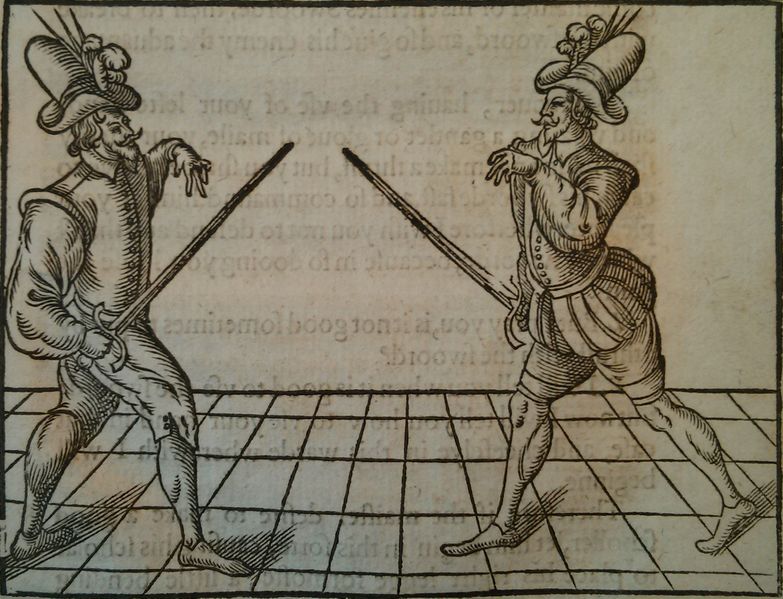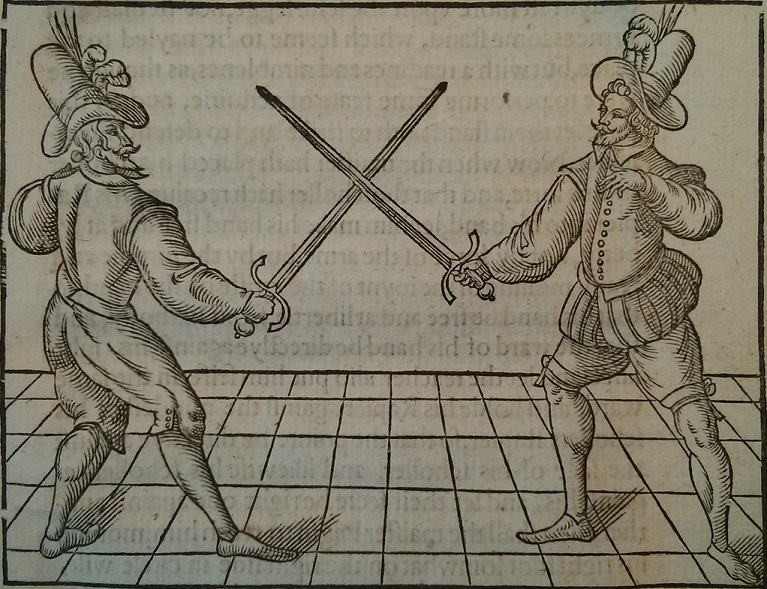

The following is a breakdown of the actions used by Saviolo. The difficult part in trying to use the existing texts is that the presentation is done in a conversational style. For modern use, we need to break down the individual elements of what Saviolo is discussing here. A second issue is that his terms are a little vague. I have used what I hope are a common set of terms, and where described in the text by Saviolo; have worked out the actions expressed and have given comments on what I think best fits the motions. However, this can change and someone else with a different understanding of these movements and terms might take a different perspective. That's a valid approach, and there is even passages noted by Saviolo which state there is a whole lot more to this than he can put in words with the limited amount of space he has.
In order to achieve a vast majority of the actions digested here; I feel it's important to put a few things into perspective.
First; DON'T BACK UP. Do not use your distance as your defense. This is not strip fencing or sport fencing. Why is this important? In every case, the master advocates taking control of the point and using the control to facilitate the strike. At no time does he say flee the attack and make them chase you down. In the event of an aggressive fighter, one stands ground and defends. Passing backward in an orderly manner to me means that a remove or a retreat from the combat is done with a specific purpose, which usually looks like gaining time for a counter and returning to a fight. There is some comment by "Luke" to the effect that giving up ground is seen as bad. I would concur and to further illustrate a point, the List that was used to fight in was a limited size field. I don't know what that means in terms of size, but I would venture that one would need to be situationally aware that their combat space could be limited if in an authorized bout, and running backward constantly in a bout could cause a disqualification.
Recall too, that in England, it may have been common to see public displays of fencing, and with the history of the Guild of London Masters, some formalization of playing at swords. We don't consider the Noble Art of Defense to be the province of street thugs, rather it has structure and formalization and order in its manner. This is why it's called an Art after all. One would have as much chance of walking down the street and finding themselves in a Rapier duel as one would end up in a chess match.
What this means in terms of how an SCA fight looks, it's pretty common for SCA people to use a sport-style approach to fencing. The idea of very long lunge thrusts with no intent to control the sword, or thrusting in an absent measure quickly and fleeing away; this is pretty much the norm for a lot of SCA fencers. It's athletic. It can be effective, but it's not in any way historical. I'm not saying lunges didn't happen, but they happened with a control element. The opponent's sword was safely rendered away and would pose no threat. The lunge would be deep, with a few feet perhaps of penetration. Not just a tip. The thrust would end up in perhaps middle measure. It would take time to run in and out. Quite frankly, a thrust that is in and out in .025 of a second wouldn't be very effective and probably didn't occur. In order to do this, don't thrust unless the opponent's sword is taken away from the fight for at least a tempo. It is very tempting to do so, but try not to. It does not mean punching firster and faster.
PROPER FORM means being in control. If you are one to insist on an athletic approach, counterpunching, and not trying to control the fight, what exactly is the point then? From a historical perspective, how you do this is as important as why. Honor is placed above life, so conduct that is in line with honor is the preferred action. One can die and retain honor, or live and lose all. Simply winning isn't the point, winning correctly is. Men would solve issues with each other using swords, but they did so as men with honor. If your opponent has to chase you down to fight you, why is there even a fight? Running backward from an opponent looks like cowardice and could be seen as either as insulting your opponent's honor or your own. Saviolo takes great pains in all his writings to emphasize the lens of honor being what all fight actions should be viewed through. Understanding the How and What of a fight leads to the enlightenment of the Why of the fight. To understand this is the key to understanding how to do this style. Winning isn't everything. Winning correctly is.
Lastly, while the SCA is something that does not place restrictions on fighting style, it does have rules which place restrictions on fighters. I like to tell people that if they run backward in a fight, and end up hurting themselves, who is at fault? It's the one attacking them, because everyone on the field is a marshal and should call a hold when something dangerous happens. Why is it expected that the defender who runs away expects the attacker to be both marshal and combatant? Too much work, and it's kind of rude.Saviolo is quick. If the paces are worked out, and I have done all of these; the measures that we end up at are middle to close. Meaning that when he says in his manuscript that you need to be fast, he means it. In nearly all these actions, there are admonitions from him saying "in the very same instant he does this, you do this." How would one know that? In middle measure experience tells me that fighters have bare fractions of a second to decide how to react This can be expressed in terms of tempo. Half tempo is about as fast as one can move. Were historical fencers slower? Maybe they were more deliberate in their movements? Without a time machine, I don't know. I do know that since most of these actions appear to be conducted at middle measure, it's very difficult to want to throw it all on an instant decision of an action and hope you are right. One small move and you are dead here. When he says you need to practice a lot, I feel that he means it.
First Ward: Sword held in Broad Ward. First is Active Dagger, second is Active Hand.


First ward: Right lead on bent right leg, weight on left foot. Low extended ward point on face. Saviolo says here that the leg is "Somewhat bent". I would take this to look close to a classic Dardi stance with the sword extended out and dagger also extended, or in close. I don't know how exacting Saviolo is in his placement of position, and he seem pretty flexible to a degree.
Actions:
Actions:
THIRD WARD:
 Third ward: Right lead The third ward in Saviolo is much like the Dardi style attack position. The front leg is bent, the weight is mostly on it, and the trailing foot is light. It can be thought of as an attack stance, it can put more steel between the fencers, and allows for a wonderful right remove back to a left lead as a means to handle attacks that get to close measure. Dagger or offhand is used active and defensive and ready to bolster the sword to brace against strong attacks, or act on it's own. The fencer on the right is in this ward.
Third ward: Right lead The third ward in Saviolo is much like the Dardi style attack position. The front leg is bent, the weight is mostly on it, and the trailing foot is light. It can be thought of as an attack stance, it can put more steel between the fencers, and allows for a wonderful right remove back to a left lead as a means to handle attacks that get to close measure. Dagger or offhand is used active and defensive and ready to bolster the sword to brace against strong attacks, or act on it's own. The fencer on the right is in this ward.
Actions: Stand in a narrow T stance, much like the picture
.
Day 1 Sword and Dagger:


Stance: Right lead, straight left arm, sword in broad ward (up by the hip, point in the face) right leg bent a little. Start in T stance.
Actions:
Starting in T stance, stepping out with first action.The next actions are a mirror of the previous ones.
1. Low stoccata with a Right slope paced step
2. Feint a stoccata and do a Left inquartata and a riversa (may be a little left slope paced step involved)
3. Thrust in with dagger, blocking the sword and offer a stoccata
4. Left pass going to alicorno (becca posa) with dagger warding for counter
A little bit of advice for how this works. Counter thrust with cuts and cuts with thrusts. Reviewing the actions here and Saviolo shows what he expected a fight to look like. Also, use Guardia DiFacia actions with the dagger included with the sword.
Second Days Discourse with Rapier and Dagger.
FIRST WARD:
 Sword held low extended ward, using a right lead. It's the guy on the left here. Stand in a right lead, sword at porta deferro stretta and left arm out straight.
Sword held low extended ward, using a right lead. It's the guy on the left here. Stand in a right lead, sword at porta deferro stretta and left arm out straight.
Dexterity, quickness and use of art are better than main strength. All of these moves must be done quickly and almost at the same time. Hard to do and needs a lot of practice. The next short sequences give some advice and methods of response to actions.